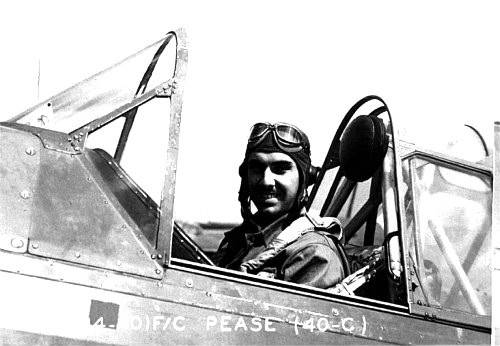Pease, Harl Jr.
- Date of birth:
- April 17th, 1910 (Plymouth/New Hampshire, United States)
- Date of death:
- August 7th, 1942 (Rabaul, East New Britain, Papua New Guinea)
- Buried on:
- American War Grave Trinity Churchyard Cemetery
- Service number:
- 0-395206
- Nationality:
- American
Biography
Promotions:
June 1940: 2nd Lieutenant.
?: 1st Lieutenant;
?: Captain.
Career:
? - 1939: University of New Hampshire;
1939: Army Air Corps;
?: 19th Bombardment Group.
Do you have more information about this person? Inform us!
- Period:
- Second World War (1939-1945)
- Rank:
- Captain
- Unit:
- 93rd Bombardment Squadron, 19th Bombardment Group, U.S. Army Air Forces
- Awarded on:
- November 4th, 1942
"For conspicuous gallantry and intrepidity above and beyond the call of duty in action with the enemy on 6 - 7 August 1942. When 1 engine of the bombardment airplane of which he was pilot failed during a bombing mission over New Guinea, Capt. Pease was forced to return to a base in Australia. Knowing that all available airplanes of his group were to participate the next day in an attack on an enemy-held airdrome near Rabaul, New Britain, although he was not scheduled to take part in this mission, Capt. Pease selected the most serviceable airplane at this base and prepared it for combat, knowing that it had been found and declared unserviceable for combat missions. With the members of his combat crew, who volunteered to accompany him, he rejoined his squadron at Port Moresby, New Guinea, at 1 a.m. on 7 August, after having flown almost continuously since early the preceding morning. With only 3 hours' rest, he took off with his squadron for the attack. Throughout the long flight to Rabaul, New Britain, he managed by skillful flying of his unserviceable airplane to maintain his position in the group. When the formation was intercepted by about 30 enemy fighter airplanes before reaching the target, Capt. Pease, on the wing which bore the brunt of the hostile attack, by gallant action and the accurate shooting by his crew, succeeded in destroying several Zeros before dropping his bombs on the hostile base as planned, this in spite of continuous enemy attacks. The fight with the enemy pursuit lasted 25 minutes until the group dived into cloud cover. After leaving the target, Capt. Pease's aircraft fell behind the balance of the group due to unknown difficulties as a result of the combat, and was unable to reach this cover before the enemy pursuit succeeded in igniting 1 of his bomb bay tanks. He was seen to drop the flaming tank. It is believed that Capt. Pease's airplane and crew were subsequently shot down in flames, as they did not return to their base. In voluntarily performing this mission Capt. Pease contributed materially to the success of the group, and displayed high devotion to duty, valor, and complete contempt for personal danger. His undaunted bravery has been a great inspiration to the officers and men of his unit."
Awarded posthumously.
War Department, General Orders No. 59 (4 November 1942).
- Period:
- Second World War (1939-1945)
- Rank:
- Captain
- Unit:
- 93rd Bombardment Squadron, 19th Bombardment Group, U.S. Army Air Forces
- Period:
- Second World War (1939-1945)
- Rank:
- Captain
- Unit:
- 93rd Bombardment Squadron, 19th Bombardment Group, U.S. Army Air Forces
Second DFC awarded in the form of a bronze oak leaf cluster to be worn on the ribbon of the first DFC.
- Period:
- Second World War (1939-1945)
- Period:
- Second World War (1939-1945)
- Period:
- Second World War (1939-1945)
- Period:
- Second World War (1939-1945)








